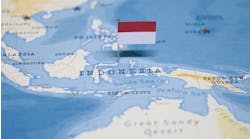PIPELINE TECHNOLOGY: Automatic earthquake-actuated device can shut down pipeline valve system
Dew to the recent surge in earthquakes, scientists and industrial developers alike have shown interest in earthquake-actuated systems that will prevent explosions from happening during and/or following an earthquake. This sort of protection is available using new, advanced earthquake detection techniques and low cost technologies. Such an automatic earthquake-actuated shut-off valve system will seal off valves on pipelines and distribution systems carrying explosive or hazardous material.
For example, an August 1999 earthquake in Turkey featured a 45-second earthquake of Richter magnitude 7.4, and was about 11 km southeast of Izmit, an industrial city 90 km east of Istanbul. The earthquake was felt over a large area, as far east as Ankara, about 320 km away. Unofficial estimates place the death toll at 30,000-40,000.
Although the collapse of commercial and residential buildings caused most of the deaths and injuries, the spectacular tank explosion that occurred at the massive Tüpras refinery in Korfez caused significant deaths and injuries due to the fires that followed the earthquake. Fire in one of the tank farms quickly spread to other tank farms through pipelines and distribution systems and burned out of control for several days, prompting an evacuation within a three-mile radius.
The loss of life and property at the Tüpras refinery could have been prevented if valves controlling pipelines and distribution systems carrying the explosive material had been shut off.
Earthquake waves
When an earthquake occurs, energy radiates outward in all directions. The energy travels through and around the earth as three types of seismic waves called primary, secondary, and surface waves. The energy of primary waves (or P waves) travels through the earth as a sequ-ence of up-and-down vibrations perpendicular to the direction of propagation of the seismic wave. Its passage through the earth causes the pushing (compression) and pulling (dilation) of particles in its path and it can travel through solids or liquids. P waves are the fastest of the three types of seismic waves. They travel through the earth 1.68 times faster than S waves.
Secondary waves (or S waves), also referred to as shear waves, travel through solids, but unlike P waves cannot travel through liquids. The energy of S waves travel through the earth as a sequence of back-and-forth vibrations in a plane (x- and y-axis) parallel to the surface of the earth. The wave's passage causes particles to vibrate in all directions _ north-south and east-west. The velocity is between that of P waves and surface waves.
Surface waves are the slowest and most destructive of the three types of seismic waves. Surface waves travel along the surface of the earth as two types of waves. One of these has a horizontal shearing motion similar to an S wave called Raleigh waves, while the other has a rolling motion in the vertical plane much like water waves called Love waves.
Device activation
There is a deterministic time difference between the arrival of the three types of waves, and that information can be built into a detection and recognition algorithm. For instance, knowing many of the characteristics of the P wave allows the detection algorithm to use it as information to move automatic earthquake activated monitoring system to move to the next state of caution.
At this point, the device begins to monitor the arrival of the S wave. When and if an S wave does appear, then shutdown of the valve (s) on the distrubtion system will begin. The reason for this is that the most destructive surface waves are approaching the station.
If no timely S wave appears, then the system will return to its original state and continue to seek out a wave group that fits the appropriate characteristics. This dependence on both of the initial body waves provides the system with an inherent robustness and fault tolerance.
- Step 1: Parameters for sampling frequency, scale factor, filter taps, and down sampling are specified and passed to the ADSP-21065L DSP chip.
- Step 2: Data is sampled into the ADSP-21065L board at sampling frequency, FS = 8000 HZ (~ 0.125 ms), and filtered using a low-pass filter to clean noise on the sampled input signal.
- Step 3: Pointers are set up for the filtered data as each input is stored in a temporary memory location on the ADSP-21065L board. The pointer is used to select one out of every 200 samples filtered. This is called down sampling and is performed to reduce the number of unwanted samples.
- Step 4: Convolution is performed on every 200th filtered signal to determine the energy magnitude of the earthquake wave. The result is scaled to a range of
Pseudo-code
The pseudo-code for processing sampled and filtered earthquake motions detected explains how the earthquake data is sampled, filtered, convoluted, stored, and compared with a pre-set energy threshold to determine the detection of a P wave. That process is as follows:
- Set up parameters for sampling frequency, scale factor, filter taps, and down sampling, and pass parameters to the ADSP-21065L DSP chip.
- Sample data at frequency specified and filter samples.
- Set up pointers for retrieving filtered data in the temporary memory, and select one filtered sample every 200 samples.
- Determine energy magnitude of the filtered sample and perform convolution.
- Store data in the FISB and compare FISB data with pre-set energy threshold values.
- Trigger if FISB data exceeds pre-set energy threshold.
- Execute a call routine to change the state of event variable and generate valve actuation signal.
Due to the recent Taiwan and Turkey earthquakes, scientists and industrial developers alike have shown renewed interest in earthquake-actuated systems that will prevent explosions from occurring during and/or following an earthquake. With the use of new advanced earthquake detection techniques and low-cost technologies, developing an automatic earthquake-actuated shut off valve system that will shut off valves on pipelines and distribution systems carrying explosive and hazardous material is now a viable design proposition.
References
Please consult author for extensive list of references.







